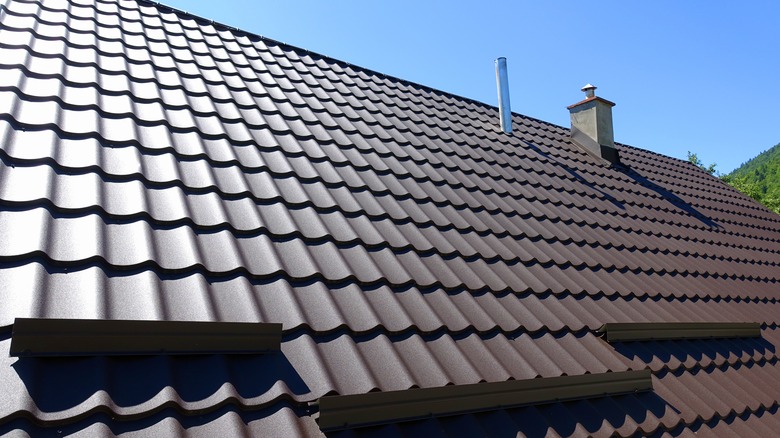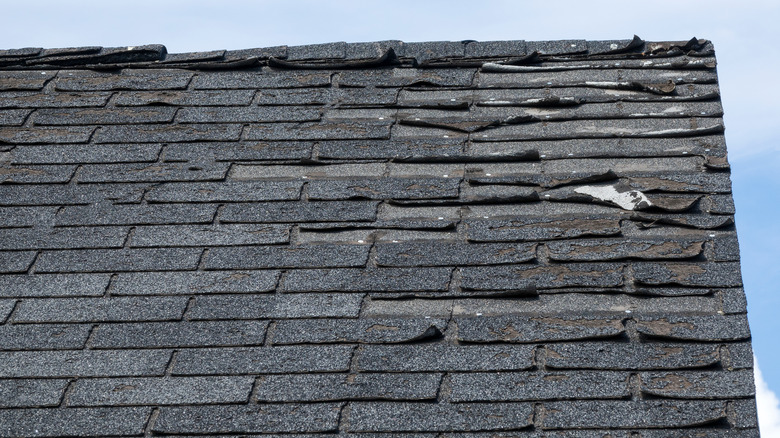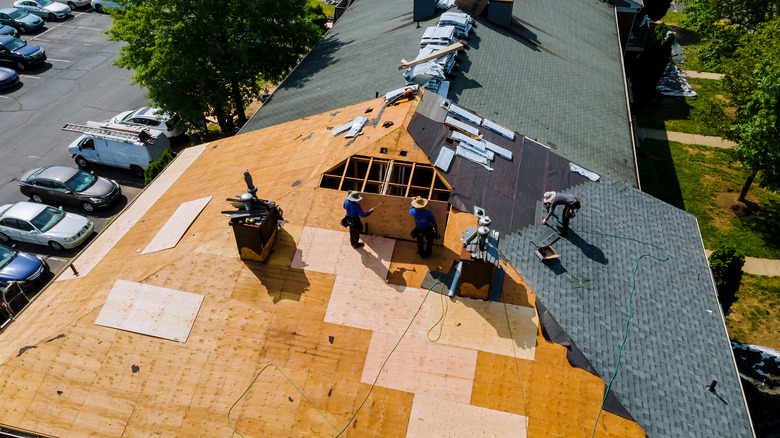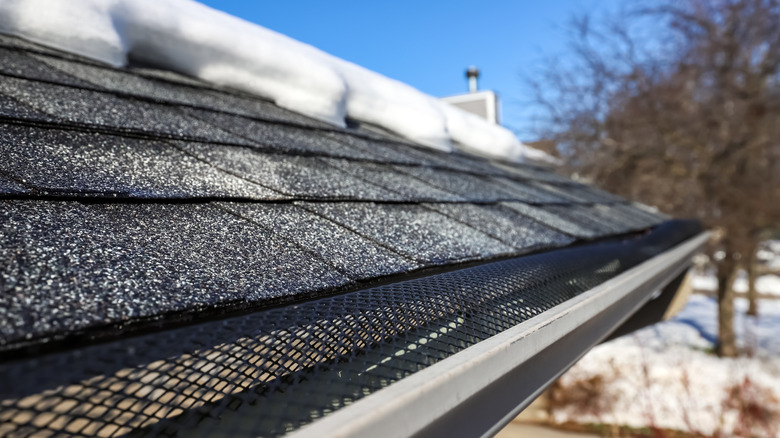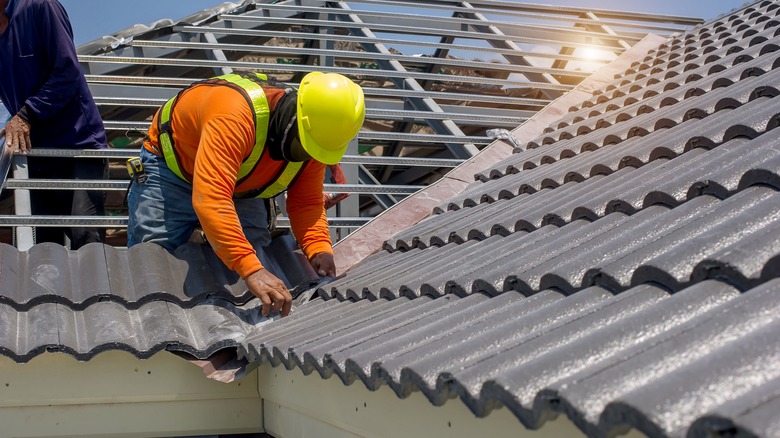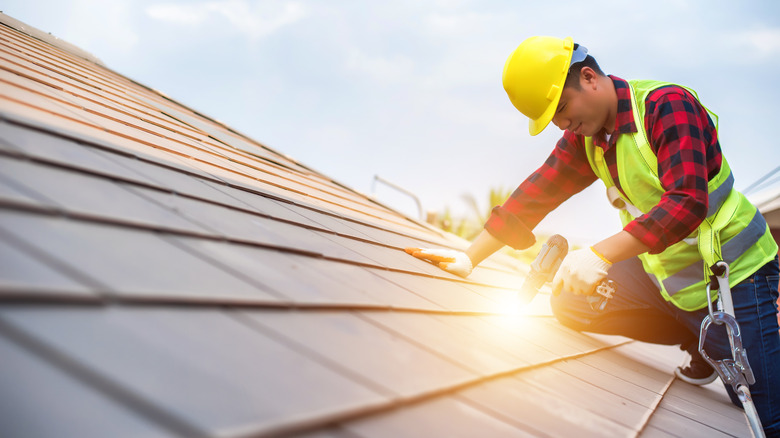When Is The Best Time Of Year To Replace Your Roof?
While roof replacements can be done year-round in most of the country, according to Joyland Roofing, there are some times throughout the year in which a roof replacement might cost more or take longer than the average. Joyland Roofing estimates that the fall and spring are the best times of year to complete a roof replacement, if at all possible. Of course, you won't always be able to dictate when you engage in your repair works. A roof failure can mean that your home will require emergency repairs or a total replacement, even if the conditions aren't at their peak.
There are many things to consider when planning out a roofing repair or replacement, but one of the most important aspects of the task is to try your best at planning ahead of time. Roof Advisor notes that it's essential to routinely investigate the soundness of the roof and all of its components. Climbing up on the roof every six months — or at the very least, once every year — will help you gain a better understanding of the wear pattern in shingles, identify potential sources of water leaks, or address rot, mold growth, and other issues that deteriorate the effectiveness of your roof. With all these things in mind, planning a roof repair can be streamlined for the best possible outcome for you and your home.
Regular inspection is vital
The first thing to take note of when preparing to repair or replace a roof is the timeline by which the work must be finished. Some homeowners are able to prepare their replacement work in advance and schedule a time that best suits their schedule. Others, on the other hand, will be saddled with an emergency repair without the benefit of choosing the most opportune season on the calendar.
Allcott Residential notes that damage to the roof can be difficult to gauge for many homeowners. Yet, if you are looking at the interior (or underside) of the roof to inspect it for wear and damage, keep an eye out for light pouring in from the exterior, spaces that are sagging, or dark streaks along the interior surface of the roof can all point to an imminent need of replacement.
The best course of action if you find any of these issues is to immediately contact a roofing contractor that you trust. Because a typical roof lasts about 20 years (via Real Homes,) you may not have worked with a roofer before. Reading customer reviews, contacting prior clients, and asking questions is the best way to gain a sense of trust and understanding when hiring a professional.
The absolute best time of year to replace a roof
Joyland Roofing reports that fall is the best season to engage in roofing replacement work. This is because roofing repairs need a combination of clear skies and generally mild weather, alongside a long day and a bit of heat. These features are hard to find packed into a single day, let alone for several days strung together. While the summer months provide the longest days, the summer heat is intense on top of the roof, with temperatures rising to as much as 20 degrees Fahrenheit above the ground temperature.
Fall provides mild weather that still retains some of the heat, which makes installing shingles and other materials easier. Similarly, fall is often a time of lower rainfall than summer or winter months in many areas, making it a great time to rip off old protective coverings to allow a new roof to take shape and then set. In order to replace a roof in the fall, you may need to speak with a roofing contractor many months in advance, though. This is a prime working window for roofing professionals, and spillover from the summer may lead to a fairly busy work schedule for many roofers in your local area.
Winter replacements may affect the costs
Some states won't allow for a winter roof replacement unless it's an absolute emergency. The coldest parts of the country see too much snow and overall chill to effectively place the necessary equipment and materials. Moreover, the heat from the sun does much of the work when it comes to installing new shingles. The heat allows for natural bonding and makes adhesive agents far more pliable, whereas, colder temperatures eliminate much of the flexibility that roofers require to get the job done quickly and accurately.
According to Renovations Roofing & Remodeling, work during the winter is more demanding on the equipment, materials, and the people performing the work. As a result, you may end up paying more for the job during the coldest part of the year. Alternatively, a milder winter climate may represent an offseason for roofers without the intensity of the cold that makes the work difficult, leading to potential savings on your roof replacement. As with any other decision regarding your roof, speaking with a contractor in advance is the best way to weigh up your options.
Summer repairs come with unique challenges
Replacing or repairing the roof during the summer months is another option that many people go for. The summer is often the busiest time for roofing contractors across the country, notes Joyland Roofing. This means that it can be difficult to find a contractor who is free on short notice. While the summer is a popular season to complete roofing maintenance, it can be a terrible time of year to need an emergency replacement.
Joyland Roofing notes that the reason that early summer is a great time to replace the roof is that humidity levels are typically lower than in the later summer months. Likewise, rain is fairly short-lived in many areas, and afternoon showers are easily predicted by local meteorologists. The weather is simply more conducive to the needs of the job than many other times throughout the year. The heat makes bending and sealing shingles or adhering tiles a simple task. While the work might be easier, however, the working conditions certainly aren't. Roofers must endure significant heat, and this makes for a more dangerous installation. Angi notes that a summer project can make for a slower installation overall, due to providing the safety precautions that contractors need.
Plan ahead as much as possible
The task of installing a new roof is unpredictable. Keeping a close eye on the state of your existing roof surface and noting any dramatic changes can help pin down the timeline for replacement more effectively, but nothing you do will specify exactly when the roof will ultimately fail.
Bob Vila notes that your routine inspection of the roofing systems should begin inside the attic. This will give you a good sense of whether elements from the exterior surface are penetrating through the exterior and influencing the atmosphere inside the home in a negative way. Looking for cracks of light coming through the dark surface is a surefire way to identify serious issues in the roof. The best course of action for any homeowner worried about their roof is to have it professionally assessed. This will highlight any issues and allow you to get a head start on the replacement process once the time comes to address the situation.
